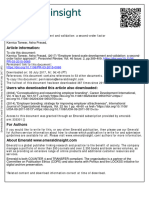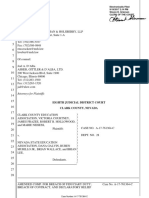Organization Structure & EthicsOrganization Climate/Culture
The organization’s values greatly influence the decisions thatindividuals make. The approach to ethical issues is not only on the basis of what the employees learned from their own background but also on the basis of what they learn from the Organizationculture and others in the organization. Organization culturecomprises of the attitudes, experiences, beliefs and values of anorganization. It can be defined as the specific collection of valuesand norms that are shared by people and groups in an organizationand that control the way people interact with each other, within andoutside the organization. An important component of corporateculture is the ethical climate. The ethical climate of an organizationis a shared set of understandings about what is correct behavior and how ethical issues are handled. This climate sets the character
for decision making at all levels and in all circumstances. Theethical climate reflects whether the firm has an ethical conscience.It is a function of many factors including corporate policies onethics, top management’s leadership on ethical issues, industryculture, etc. The ethical tendency or climate of organizations is setat the top. What top managers do, the culture they establish andreinforce, makes a huge difference in the way employees act in theorganization, when ethical dilemmas are faced. When the ethicalclimate is unclear or negative, ethical dilemmas often result inunethical behavior. Organizations have ethics programme as a wayof minimizing the risk of ethical misconduct or wrong doing byemployees. These programs consist of policies, processes,education and training initiatives that explain the company’s business ethics. These programmes clarify how ethics shouldtranslate into operating procedures and workplace behaviour. The
focus of ethics programme is compliance with rules andregulations.
ORGANIZATION STRUCTURE AND ETHICS
An organization’s structure is important to the study of businessethics. In a centralized organization, decision-making authority isconcentrated in the hands of top-level managers, and littleauthority is delegated to lower levels. Responsibility, both internaland external, rests with top management. This structure isespecially suited for organizations that make high-risk decisionsand whose lower-level managers are not highly skilled in decisionmaking. It is also suitable for organizations in which production processes are routine and efficiency is of primary importance.These organizations are usually extremely bureaucratic, and the
division of labour is typically very well defined. Each worker knows his or her job and what is specifically expected of him/her,and each has a clear understanding of how to carry out assignedtasks. Centralized organizations stress on formal rules, policies,and procedures, backed up with elaborate control systems. Their codes of ethics may specify the techniques to be used for decisionmaking. Because of the top-down approach and the distance between employee and decision maker, centralized organizationalstructures can lead to unethical acts. If the centralized organizationis very bureaucratic, some employees may behave according to“the letter of the law” rather than the spirit. In a decentralizedorganization, decision-making authority is delegated as far downthe chain of command as possible. Such organizations haverelatively few formal rules, coordination and control are usuallyinformal and personal. They focus on increasing the flow of








